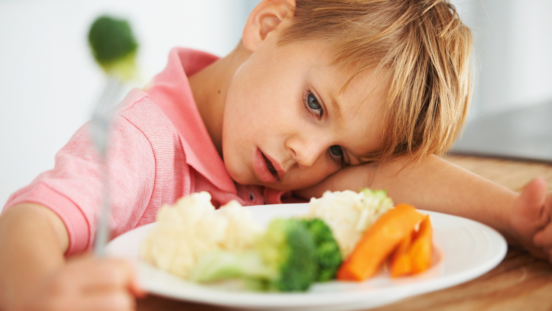Feeding toddlers: Creating healthy eating habits
Let the games begin!
Five serves of this, two of that, skip the salt and sugar, don't overdo the fats and make sure your toddler is getting enough red meat and milk – but the right kind of milk. Throw in a little food fussiness and you have a recipe for wondering what makes up a balanced diet.
Feeding toddlers can be a worry for parents. With childhood obesity a major issue for governments worldwide, the healthy eating messages are coming at parents thick and fast. In Australia, one in four children aged between two and three is considered overweight or obese, so there's every reason to consider carefully what we're feeding our kids. But it can be hard to balance healthy eating advice with preparing a daily menu for toddlers.
Nutritionist expert Joanna McMillan believes one of the best things parents can do about their toddler's eating is to relax, so long as they're providing nutritious and varied home-cooked meals, and not going overboard on the processed snacks and juices.
It sounds easy, but every household has dramas over food, even the McMillan one. "I'm a mum, too," says Joanna. "We've had those nightmare meals where I'm cross because no-one's eaten the food I took so long to prepare!"
Read on as Joanna sifts through the advice on healthy eating, translating it into useful information you can put into practice with your little one.
Busting the fruit and veg myth
The advice to eat five serves of vegetables and two serves of fruit is for adults. Young kids don't need this much and you'd never expect a child to eat this much greenery, says Joanna. Government guidelines advise your little one eats two to three serves of vegetables a day and half a serve of fruit.
"Parents panic about how many serves of fruit and veg they're giving their children," says Joanna. "But the most important thing at this young age is to expose them to different tastes and textures. Try to get them to taste a little bit of everything. Instead of focusing on quantity, it's more important that they try different foods, and make sure the food is minimally processed."
Rather than serving vegetables up on a plate as a steaming pile that must be eaten, make them a composite part of your toddler's meal by including them in a stir-fry or adding to a pasta sauce. Encourage your children to taste new food, and don't worry if they don't finish eating it or decide they don't like it.
"You sometimes have to offer a serve of food up to 15 times before a toddler accepts it," says Joanna. "So be patient – and persistent – and don't give up trying after your first attempt."

It can be hard to balance healthy eating advice with preparing a daily menu for toddlers.
Protein plus
Crucial for your toddler's development and growth, eating protein is even more important than vegetables. "For adults, the palm of your hand is a good guide for working out protein serving sizes, and this works well for kids, too," says Joanna, who adds you should offer meat, fish or some other kind of protein (such as baked beans or eggs) at each of your toddler's main meals every day.
Many parents find their children, especially younger ones, struggle to swallow meat, but Joanna says mince is a great way to help them chew it and get it down. And if you imagine the size of your toddler's fist as the size of his stomach, you'll soon realise you won't need to offer big portions of each type of food. Include a few different vegetables, some carbohydrate and protein at every meal and you're well on your way to ensuring your toddler has a healthy diet.
Milk it
Children under the age of two should drink full-fat milk, but from the age of two onwards you can introduce them to reduced-fat milk and, from five years, skimmed milk. Younger children need the extra kilojoules from full-fat milk, but as they grow older they don't need the energy as much.
"It's up to you which type of milk you choose for your family," says Joanna. "The latest research shows that full-fat and low-fat milks can be helpful with weight control. The issue is really one of quantity."
Joanna advises that if your child is not going over the recommended dairy serves a day, then serving full-fat milk is fine. However if the rest of the family prefers a low-fat milk then your children can have the same from age two.
And toddlers only need one to two cups of milk a day, so be careful about letting them fill up on the creamy stuff and not wanting to eat their meals. "They don't need more any milk than that, so there's no need to give milk at every meal or between meals," Joanna says.
The honey sandwich trap
Above all, don't fall into the trap of taking the easy alternative when it comes to preparing healthy meals. If you do, your toddler will soon discover that if he holds out, you'll cave in and produce the honey sandwich. "No kid will let himself starve, so just try to encourage healthy, positive eating behaviour," says Joanna. "Instead of making dinner a rushed, stressful affair, take time to sit down with your kids." And if they taste their food and say they don't like it, don't force them to eat it.
Of course, sweet treats such as lollies and biscuits shouldn't become a regular part of your toddler's diet, but don't go overboard either. "Just teach children a good attitude towards food," says Joanna.
"Teach them about good nutrition and encourage them to enjoy their food and you'll be on the right track."
WATCH: Tips for dining out with toddlers. Continues after video …
ON THE MENU
Nutritionist Joanna McMillan's sample menu for an 18-month-old
Breakfast
Half a cup of cooked porridge made with traditional oats. Topped with a spoonful of natural full-fat yoghurt and a few sliced strawberries and blueberries.
Snack
Half a slice of wholegrain toast with ABC spread (almonds, Brazil nuts and cashews) and a little drizzle of honey.
Lunch
A finger food plate of carrot sticks, cucumber sticks, cherry tomatoes, two slices of chicken and three wholegrain crackers spread with avocado, followed by a small carton of yoghurt.
Snack
Banana sandwich made with half a slice of wholegrain bread and a quarter of a banana, plus half a cup of milk.
Dinner
Half a cup of wholemeal pasta with a tomato-based sauce, made with tinned tuna, borlotti beans and corn.




